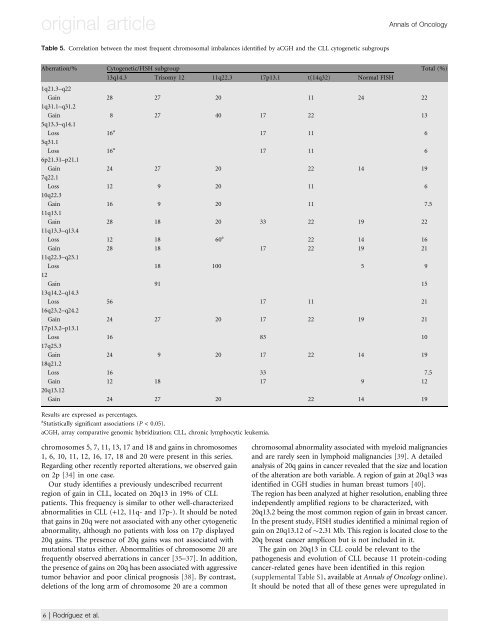Alberto Risueño Pérez - Gredos - Universidad de Salamanca
Alberto Risueño Pérez - Gredos - Universidad de Salamanca
Alberto Risueño Pérez - Gredos - Universidad de Salamanca
You also want an ePaper? Increase the reach of your titles
YUMPU automatically turns print PDFs into web optimized ePapers that Google loves.
original article<br />
Table 5. Correlation between the most frequent chromosomal imbalances i<strong>de</strong>ntified by aCGH and the CLL cytogenetic subgroups<br />
Aberration/% Cytogenetic/FISH subgroup Total (%)<br />
13q14.3 Trisomy 12 11q22.3 17p13.1 t(14q32) Normal FISH<br />
1q21.3–q22<br />
Gain<br />
1q31.1–q31.2<br />
28 27 20 11 24 22<br />
Gain<br />
5q13.3–q14.1<br />
8 27 40 17 22 13<br />
Loss 16 a<br />
5q31.1<br />
17 11 6<br />
Loss 16 a<br />
6p21.31–p21.1<br />
17 11 6<br />
Gain<br />
7q22.1<br />
24 27 20 22 14 19<br />
Loss<br />
10q22.3<br />
12 9 20 11 6<br />
Gain<br />
11q13.1<br />
16 9 20 11 7.5<br />
Gain<br />
11q13.3–q13.4<br />
28 18 20 33 22 19 22<br />
Loss 12 18 60 a<br />
22 14 16<br />
Gain<br />
11q22.3–q23.1<br />
28 18 17 22 19 21<br />
Loss<br />
12<br />
18 100 5 9<br />
Gain<br />
13q14.2–q14.3<br />
91 15<br />
Loss<br />
16q23.2–q24.2<br />
56 17 11 21<br />
Gain<br />
17p13.2–p13.1<br />
24 27 20 17 22 19 21<br />
Loss<br />
17q25.3<br />
16 83 10<br />
Gain<br />
18q21.2<br />
24 9 20 17 22 14 19<br />
Loss 16 33 7.5<br />
Gain<br />
20q13.12<br />
12 18 17 9 12<br />
Gain 24 27 20 22 14 19<br />
Results are expressed as percentages.<br />
a Statistically significant associations (P < 0.05).<br />
aCGH, array comparative genomic hybridization; CLL, chronic lymphocytic leukemia.<br />
chromosomes 5, 7, 11, 13, 17 and 18 and gains in chromosomes<br />
1, 6, 10, 11, 12, 16, 17, 18 and 20 were present in this series.<br />
Regarding other recently reported alterations, we observed gain<br />
on 2p [34] in one case.<br />
Our study i<strong>de</strong>ntifies a previously un<strong>de</strong>scribed recurrent<br />
region of gain in CLL, located on 20q13 in 19% of CLL<br />
patients. This frequency is similar to other well-characterized<br />
abnormalities in CLL (+12, 11q- and 17p-). It should be noted<br />
that gains in 20q were not associated with any other cytogenetic<br />
abnormality, although no patients with loss on 17p displayed<br />
20q gains. The presence of 20q gains was not associated with<br />
mutational status either. Abnormalities of chromosome 20 are<br />
frequently observed aberrations in cancer [35–37]. In addition,<br />
the presence of gains on 20q has been associated with aggressive<br />
tumor behavior and poor clinical prognosis [38]. By contrast,<br />
<strong>de</strong>letions of the long arm of chromosome 20 are a common<br />
6 | Rodríguez et al.<br />
Annals of Oncology<br />
chromosomal abnormality associated with myeloid malignancies<br />
and are rarely seen in lymphoid malignancies [39]. A <strong>de</strong>tailed<br />
analysis of 20q gains in cancer revealed that the size and location<br />
of the alteration are both variable. A region of gain at 20q13 was<br />
i<strong>de</strong>ntified in CGH studies in human breast tumors [40].<br />
The region has been analyzed at higher resolution, enabling three<br />
in<strong>de</strong>pen<strong>de</strong>ntly amplified regions to be characterized, with<br />
20q13.2 being the most common region of gain in breast cancer.<br />
In the present study, FISH studies i<strong>de</strong>ntified a minimal region of<br />
gain on 20q13.12 of 2.31 Mb. This region is located close to the<br />
20q breast cancer amplicon but is not inclu<strong>de</strong>d in it.<br />
The gain on 20q13 in CLL could be relevant to the<br />
pathogenesis and evolution of CLL because 11 protein-coding<br />
cancer-related genes have been i<strong>de</strong>ntified in this region<br />
(supplemental Table S1, available at Annals of Oncology online).<br />
It should be noted that all of these genes were upregulated in
















